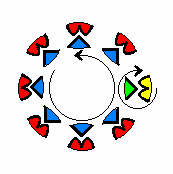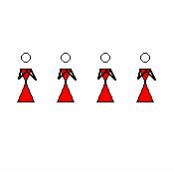Dona Bleska (Doudlebska Polka) - dance of many couples, a mixer
|
bar 1-10
(16 bars) |
 |
Polka:
Couple wise polka in the line of dancing in the ballroom. |
bar 11-21
(16 bars) |
 |
Train:
Walk couple wise in a big circle after one another,
lady has her left hand on her gents right shoulder, gent has his right
arm around his ladies waist (open peasant hold), and he has his left hand
on the left shoulder of the gent in front of him.
(Make the circle not too big to make it closed).
See photo of the "train". |
bar 22-32
(16 bars) |
 |
Claps:
Gents get together in an inner circle and stand and clap,
first 3 times in own hands,
then 3 times in neighbours' hands;
then own hands, then neighbours hands, etc.
Ladies walk the outer circle and she selects a gent's back to stand
behind,
until he turns around for the polka (see his joyful surprise seeing
you).
Next time with this phrase the ladies clap and the gents select a new
partner. |
| The clapping of neighbouring hands is further illustrated
below: |
bar 22-32
(16 bars) |
 |
Clapping neighbour hands:
Right hand, palm down, claps downward from above,
left hand, palm up, claps upward from below. |
The dance is traditionally from Czechoslovakia where it may be danced
slightly different and the claps may be rather much different. At other
places in Europe it may be more different (and also be named different).
To avoid all those evening long theoretical discussions about what is wrong
and right in Doudlebska Polka it was once upon a time proposed to call
the dance here by a new name: Dona Bleska, and instead of discussions about
Doudlebska Polka use the time for dancing Dona Bleska.





